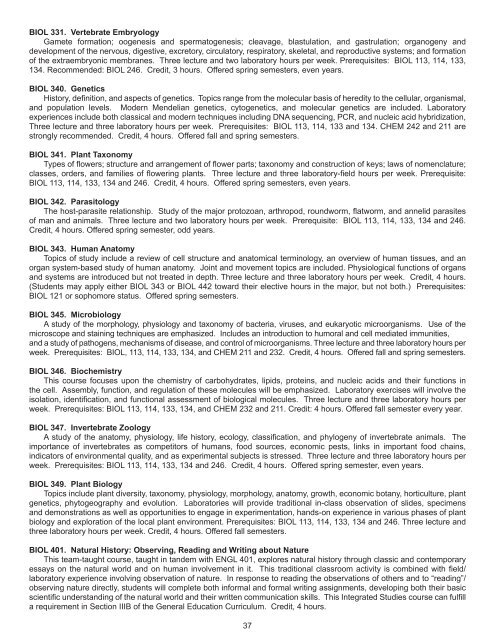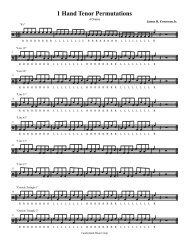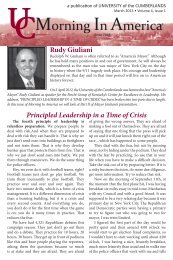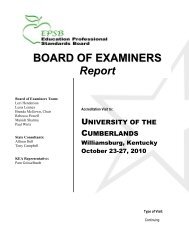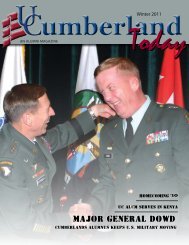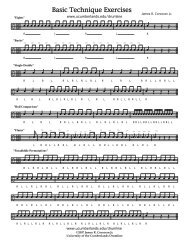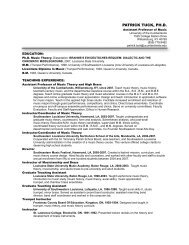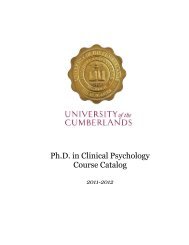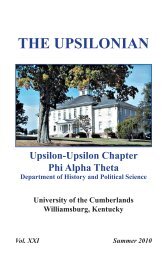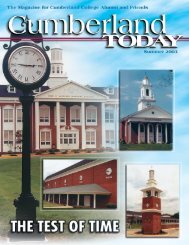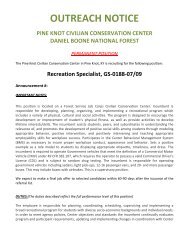2013â2014 Undergraduate Catalog - University of the Cumberlands
2013â2014 Undergraduate Catalog - University of the Cumberlands
2013â2014 Undergraduate Catalog - University of the Cumberlands
Create successful ePaper yourself
Turn your PDF publications into a flip-book with our unique Google optimized e-Paper software.
BIOL 331. Vertebrate Embryology<br />
Gamete formation; oogenesis and spermatogenesis; cleavage, blastulation, and gastrulation; organogeny and<br />
development <strong>of</strong> <strong>the</strong> nervous, digestive, excretory, circulatory, respiratory, skeletal, and reproductive systems; and formation<br />
<strong>of</strong> <strong>the</strong> extraembryonic membranes. Three lecture and two laboratory hours per week. Prerequisites: BIOL 113, 114, 133,<br />
134. Recommended: BIOL 246. Credit, 3 hours. Offered spring semesters, even years.<br />
BIOL 340. Genetics<br />
History, definition, and aspects <strong>of</strong> genetics. Topics range from <strong>the</strong> molecular basis <strong>of</strong> heredity to <strong>the</strong> cellular, organismal,<br />
and population levels. Modern Mendelian genetics, cytogenetics, and molecular genetics are included. Laboratory<br />
experiences include both classical and modern techniques including DNA sequencing, PCR, and nucleic acid hybridization,<br />
Three lecture and three laboratory hours per week. Prerequisites: BIOL 113, 114, 133 and 134. CHEM 242 and 211 are<br />
strongly recommended. Credit, 4 hours. Offered fall and spring semesters.<br />
BIOL 341. Plant Taxonomy<br />
Types <strong>of</strong> flowers; structure and arrangement <strong>of</strong> flower parts; taxonomy and construction <strong>of</strong> keys; laws <strong>of</strong> nomenclature;<br />
classes, orders, and families <strong>of</strong> flowering plants. Three lecture and three laboratory-field hours per week. Prerequisite:<br />
BIOL 113, 114, 133, 134 and 246. Credit, 4 hours. Offered spring semesters, even years.<br />
BIOL 342. Parasitology<br />
The host-parasite relationship. Study <strong>of</strong> <strong>the</strong> major protozoan, arthropod, roundworm, flatworm, and annelid parasites<br />
<strong>of</strong> man and animals. Three lecture and two laboratory hours per week. Prerequisite: BIOL 113, 114, 133, 134 and 246.<br />
Credit, 4 hours. Offered spring semester, odd years.<br />
BIOL 343. Human Anatomy<br />
Topics <strong>of</strong> study include a review <strong>of</strong> cell structure and anatomical terminology, an overview <strong>of</strong> human tissues, and an<br />
organ system-based study <strong>of</strong> human anatomy. Joint and movement topics are included. Physiological functions <strong>of</strong> organs<br />
and systems are introduced but not treated in depth. Three lecture and three laboratory hours per week. Credit, 4 hours.<br />
(Students may apply ei<strong>the</strong>r BIOL 343 or BIOL 442 toward <strong>the</strong>ir elective hours in <strong>the</strong> major, but not both.) Prerequisites:<br />
BIOL 121 or sophomore status. Offered spring semesters.<br />
BIOL 345. Microbiology<br />
A study <strong>of</strong> <strong>the</strong> morphology, physiology and taxonomy <strong>of</strong> bacteria, viruses, and eukaryotic microorganisms. Use <strong>of</strong> <strong>the</strong><br />
microscope and staining techniques are emphasized. Includes an introduction to humoral and cell mediated immunities,<br />
and a study <strong>of</strong> pathogens, mechanisms <strong>of</strong> disease, and control <strong>of</strong> microorganisms. Three lecture and three laboratory hours per<br />
week. Prerequisites: BIOL, 113, 114, 133, 134, and CHEM 211 and 232. Credit, 4 hours. Offered fall and spring semesters.<br />
BIOL 346. Biochemistry<br />
This course focuses upon <strong>the</strong> chemistry <strong>of</strong> carbohydrates, lipids, proteins, and nucleic acids and <strong>the</strong>ir functions in<br />
<strong>the</strong> cell. Assembly, function, and regulation <strong>of</strong> <strong>the</strong>se molecules will be emphasized. Laboratory exercises will involve <strong>the</strong><br />
isolation, identification, and functional assessment <strong>of</strong> biological molecules. Three lecture and three laboratory hours per<br />
week. Prerequisites: BIOL 113, 114, 133, 134, and CHEM 232 and 211. Credit: 4 hours. Offered fall semester every year.<br />
BIOL 347. Invertebrate Zoology<br />
A study <strong>of</strong> <strong>the</strong> anatomy, physiology, life history, ecology, classification, and phylogeny <strong>of</strong> invertebrate animals. The<br />
importance <strong>of</strong> invertebrates as competitors <strong>of</strong> humans, food sources, economic pests, links in important food chains,<br />
indicators <strong>of</strong> environmental quality, and as experimental subjects is stressed. Three lecture and three laboratory hours per<br />
week. Prerequisites: BIOL 113, 114, 133, 134 and 246. Credit, 4 hours. Offered spring semester, even years.<br />
BIOL 349. Plant Biology<br />
Topics include plant diversity, taxonomy, physiology, morphology, anatomy, growth, economic botany, horticulture, plant<br />
genetics, phytogeography and evolution. Laboratories will provide traditional in-class observation <strong>of</strong> slides, specimens<br />
and demonstrations as well as opportunities to engage in experimentation, hands-on experience in various phases <strong>of</strong> plant<br />
biology and exploration <strong>of</strong> <strong>the</strong> local plant environment. Prerequisites: BIOL 113, 114, 133, 134 and 246. Three lecture and<br />
three laboratory hours per week. Credit, 4 hours. Offered fall semesters.<br />
BIOL 401. Natural History: Observing, Reading and Writing about Nature<br />
This team-taught course, taught in tandem with ENGL 401, explores natural history through classic and contemporary<br />
essays on <strong>the</strong> natural world and on human involvement in it. This traditional classroom activity is combined with field/<br />
laboratory experience involving observation <strong>of</strong> nature. In response to reading <strong>the</strong> observations <strong>of</strong> o<strong>the</strong>rs and to “reading”/<br />
observing nature directly, students will complete both informal and formal writing assignments, developing both <strong>the</strong>ir basic<br />
scientific understanding <strong>of</strong> <strong>the</strong> natural world and <strong>the</strong>ir written communication skills. This Integrated Studies course can fulfill<br />
a requirement in Section IIIB <strong>of</strong> <strong>the</strong> General Education Curriculum. Credit, 4 hours.<br />
37


